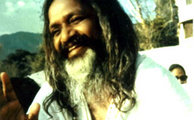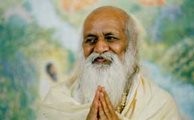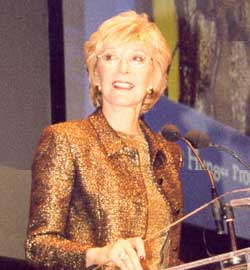By Bronte Baxter
The climate of the 60s: America was to question everything, challenge “the system” and the established world view.
 Experimenting with sex and drugs, toying with every new or forbidden philosophy. A better world was around the corner “ we were sure of it. Soon we’d be, as Arlo sang, “walking hand in hand with every man, sleeping in the sun with everyone.”
Experimenting with sex and drugs, toying with every new or forbidden philosophy. A better world was around the corner “ we were sure of it. Soon we’d be, as Arlo sang, “walking hand in hand with every man, sleeping in the sun with everyone.”
What happened?
Where have all the flower children gone?
Some became followers of Maharishi Mahesh Yogi, the founder of Transcendental Meditation (TM) and the Students International Meditation Society (SIMS), an organization that descended on US campuses, recruited kids and cleaned them up, turning them into “upstanding members of society.”
TM gave them a mantra and taught them to meditate.
Hippies turned TM converts, trading in swear words for mantras, tie-dyed shirts for three-piece suits.
Many kids were recruited to become teachers, pulling in still more people.
 In 1975, Merv Griffin featured Maharishi (1975 photo right) on his prime-time TV show then started TM himself. First promoted by the Beatles, the giggling guru’s meditation program went mainstream, with courses taught in corporations and schools so that executives could relax and students could focus.
In 1975, Merv Griffin featured Maharishi (1975 photo right) on his prime-time TV show then started TM himself. First promoted by the Beatles, the giggling guru’s meditation program went mainstream, with courses taught in corporations and schools so that executives could relax and students could focus.
A virtual army of TM teachers covered the globe, with centers in every major city, talks in every suburb. Maharishi said that world peace would happen “ better yet, an ideal world “ when enough people globally found inner peace by practicing TM.
I was among that army, personally instructing 350 people in the course of six years.
I fell in love with a starry-eyed boy, and we were going to create utopia together.
We preached the message of transcendence: taking the mind inward to bask in its Source, the state of pure awareness, from which all good things spring. We drank of those waters daily. Refreshed from contact with the supreme, we’d return to the world energized for more lectures and teaching.
It was a glorious time. Hope was everywhere. Gone was the contentiousness of our generation. We were avant-garde leaders now, shouting a new message, a new answer, to the world.
Challenging authority became a thing of the past. (Maharishi taught that people should respect it..) Working within the system, we were told we would bring about change, and change would happen by raising people’s consciousness.
Get them all to meditate, and problems would vanish from this earth.
We truly believed it. The idea was radical, new, and to our young minds it made sense.
TM opened a brand-new vista on the future, where troubles, all supposedly born of man’s separation from his pure infinite nature, would spontaneously disappear.
The ex-hippie TM army was passionate: our full love and energy went into achieving Maharishi’s dream for the world.
Recruits who didn’t feel called to become teachers found their way in businesses and vocations, becoming productive members of society. Those from wealthy families supported the movement with gargantuan donations, and received places of influence directly under Maharishi. It was only a matter of time until the world would be transformed and mankind would enter a New Age. Maharishi called it The Age of Enlightenment.
But something happened on the way to paradise.
 Slowly and subtly, the tone of the guru’s teachings changed.
Slowly and subtly, the tone of the guru’s teachings changed.
What used to be 20 minutes twice a day became hour-long, then 90-minute, meditations. The mantras were reshaped into “advanced techniques,” and chanting and Vedic readings (hymns to the gods) began.
In a bold move, Maharishi began teaching courses in TM-Siddhis, a slew of paranormal abilities which he said humans could develop. Turning invisible was one of the siddhis; levitation was another.
People that took the siddhi training, were told that it would elevate their consciousness. But instead of flying, people were bouncing around cross-legged on foam rubber mats on their posteriors.
Flying is coming, Maharishi promised “ keep practicing: frog-hopping is only the beginning stage.
No one turned invisible, and no one demonstrated any of the other special abilities the several-thousand-dollar siddhi course was supposed to teach.
At the time of this writing, 30 years after the inception of the TM-siddhis, no one in Maharishi’s organization has yet demonstrated any levitation beyond frog-hopping.
 Meanwhile the movement snapped photos of smiling butt-bouncers (photo right) caught in mid-air and plastered the pictures on posters and fliers as advertisements: “Come learn yogic flying.”
Meanwhile the movement snapped photos of smiling butt-bouncers (photo right) caught in mid-air and plastered the pictures on posters and fliers as advertisements: “Come learn yogic flying.”
TM teachers who completed siddhi training were called “Governors of the Age of Enlightenment,” because Maharishi said our elevated consciousness would regulate negative tendencies in the world. Governors were told not to reveal to TM teachers or meditators that butt-bouncing was all that was being achieved on the siddhi courses to date.. That would spoil the innocence of the new initiates, interfering with their ability to learn.
For the first time, more than a few disciples started questioning. Why was TM deceitful in its advertising, pretending that people were flying?
Why were we asked to pay thousands of dollars for something that didn’t work?
And how had a simple meditation technique, that was supposed to be all we needed for cosmic consciousness, gotten so complicated?
Originally, we signed on for a non-religious “relaxation technique,” practiced a few minutes twice daily as an adjunct to dynamic activity.
TM had its roots in Hinduism, but we had ignored that.
As teachers or “initiators,” we had to perform a “puja,” a ritual of offerings performed on an altar before a picture of Guru Dev, Maharishi’s master. We were ordered to do this in the presence of every new initiate before dispensing their mantra. We were to kneel down and bow before the picture, making a hand gesture to indicate that the student was expected to kneel down, too.
At the time we teachers convinced ourselves that we weren’t being deceptive. Maharishi said the initiates would understand in time, after their consciousness was raised through meditation. He repeatedly told us that TM was not a religion. As if saying it enough would make it so!
But when the TM-Siddhis started, things got even more religious.
We were instructed to read prayers to the gods after every meditation and to listen to audiotapes of chants to Hindu deities as we fell asleep at night. Maharishi reassured us: the gods are not actual personal entities but “impulses of creative intelligence” that exist within ourselves. The fact that Hinduism anthropomorphizes deities, just signals immature consciousness he said, and that of course was something the movement was far too sophisticated to be guilty of.
The changes in the movement were so gradual that I hardly blinked an eye the day I got my own advanced technique, which consisted of adding the Sanskrit word “namah” to my original mantra. I didn’t quite understand, as I was told the mantras were meaningless sounds that have a beneficial effect on the nervous system. I didn’t know any translation for my mantra “Eima,” but I did know, from the puja, what “namah” meant in English. It means, “I bow down.” Who was I bowing down to, I wondered? Well, it must be a god. “Eima” must be a name for her, and she must be my escort on the path to higher consciousness. Another hidden teaching, obvious only to an advanced spiritual aspirant. I felt privileged and superior to be let in on the secret.
Around this time in the movement, many people started to complain of physical problems, as well as irritability and/or depression..
Once I was assigned to spend the night guarding one meditator who was being sent home from a siddhi course because she was “unstable.” She was being shipped out the following day, and course leaders were concerned that she might harm herself or create an embarrassing scene in the meantime, hence her need for a “guard.”
In 1978, an article appeared in Psychology Today reporting that “a substantial number” of individuals develop “anxiety, depression, physical and mental tension and other adverse effects” from meditating. (San Francisco Examiner, September 10, 1989) The scientific criticism was just starting.
While over a hundred studies had been done by TM scientists showing outstanding benefits from TM for mind and body, new studies by independent researchers failed to corroborate such claims.
Some new studies even suggested adverse mental and physical effects resulting from meditation (depersonalization, the onset of mental difficulties, psychological disorders).
TM was accused of failing to conduct double-blind experiments, and of influencing test results with the prejudice of the tester.
One insider, a friend of mine who was exceptionally devoted to Maharishi and who worked with TM psychologists as their research assistant, became shaken and left the movement when she found the scientists she worked with doctoring test results to make them better conform to Maharishi’s desired outcomes. (See the following site for more about independent studies done on meditators:http://minet.org/TM-EX/Winter-94)
Around this time, people started leaving the movement, but most of us held strong.
 A meditating community had sprung up in
A meditating community had sprung up in
Maharishi began mens’ and women’s monastic groups (the Purusha and Mother Divine programs) and encouraged people to join them as “the most rapid lifestyle for unfolding enlightenment.”
People gave up dreams of love and a family to follow their guru’s advice, believing they were serving their enlightenment and the highest social good.
 My best friend, intensely in love with her husband, was divorced by him when the monastic programs started. He became a celibate, while my friend tried to live as a nun with her broken heart. Within months she developed cancer, dying a couple years later. She forewent Western treatment to pursue an alternative healing system:
My best friend, intensely in love with her husband, was divorced by him when the monastic programs started. He became a celibate, while my friend tried to live as a nun with her broken heart. Within months she developed cancer, dying a couple years later. She forewent Western treatment to pursue an alternative healing system:
What troubled me most about the movement in the 80s was a growing sense of subterfuge and surveillance amidst an atmosphere of increasingly artificial “positivity.” Movement leaders instructed the rank and file to “never entertain negativity,” which meant never criticize and always wear a happy face.
There was a sense that we were being watched, that unknown people within the organization had been assigned as spies for the rest of us.
Any person suspected of entertaining doubts about Maharishi and the movement or visiting other spiritual teachers would find themselves refused admittance to new courses or group meditations in the central “flying” hall. The outcasts were never told what they had done to merit excommunication. “You know,” was the cryptic reply, or “Reapply in a few months” whenever the rejects asked, “But what did I do?”
The significance of being tossed out by the TM movement was devastating to those it happened to. The depth of their turmoil can only be fathomed by understanding that Maharishi was teaching then that
Our goal was liberation, enlightenment: an egoless state where blissful “pure consciousness” suffuses the awareness at all times, trivializing everything that used to seem important. In enlightenment, nothing touches you, success and loss don’t affect you.
Because liberation in this lifetime required staying on the good side of the TM “gestapo,” people became artificial and prone to quoting movement slogans in front of each other. Everyone wanted to appear “kosher,” so they could stay on the campus and evolve.
 The movie Man on the Moon depicts what happened to Andy Kaufman (photo left), a Hollywood comedian and TM governor who after years of movement involvement was found to be mysteriously wanting. There is a scene where a smiling TM-Siddhi administrator informs him he is not welcome on Maharishi’s campus anymore, no reason given. For an earnest meditator, that was like telling a cancer patient the drug he needs to live is being withdrawn.
The movie Man on the Moon depicts what happened to Andy Kaufman (photo left), a Hollywood comedian and TM governor who after years of movement involvement was found to be mysteriously wanting. There is a scene where a smiling TM-Siddhi administrator informs him he is not welcome on Maharishi’s campus anymore, no reason given. For an earnest meditator, that was like telling a cancer patient the drug he needs to live is being withdrawn.
In 1987, when I left TM and
In the 20 years since I left the Transcendental Meditation movement, Maharishi raised the price for learning to meditate into the thousands. Disciples able and willing to kick in a million dollars (apiece) were offered (in the last years of the guru’s life) proximity to him, a golden crown to wear, and the title of “raja” or “king”. Maharishi had created a “world government” he called “The Global Country of World Peace,” and his rajas are the rulers.
I’ve come to personally know two women who confide they were sexually propositioned by the “lifelong monk.”
One of Maharishi’s closest disciples from the 70s, a Swedish man named Conny Larson, published an autobiography in which he says he left the TM movement when he realized the girls who came into Maharishi’s room in the wee hours, leaving disheveled, weren’t really in there “reading him his mail.”
Since Maharishi’s death last February, one of his former girlfriends, Linda Pearce, is expected to come forward with her full story (first covered in a newspaper article in 1981, some years after John Lennon announced in a Rolling Stone interview that the Beatles believed Maharishi had tried to rape Mia Farrow).
In the years since I left the movement, the truth about the mantras has also come out.
The mantras (which Maharishi gave to the teachers to give in turn to the lower initiates) turn out not to be “meaningless sounds with life-supporting qualities” as he said. They are, rather, names of Hindu gods, a fact made public with the advent of the Internet.
Wikipedia, in its section on mantras, lists three of the mantras Maharishi gave me and other teachers to dispense: Eim, Hrim, and Shreem. Eim, says Wikipedia, is the Hindu goddess Saraswati, Hrim is the goddess Durga, and Shreem is the goddess Kali. (Wikipedia quotes these facts from “The Shakti Mantras,” by Thomas Ashley Farrand, Ballantine Books, 2003, pages 43, 124 and 138, but you can find the same information appearing dozens of places in a simple Google search.)
This intentional deception by Maharishi, perpetrated on his teachers and through them on the public, is to me the worst thing this “man of God” did to society. Through this lie, telling us that the mantras were “meaningless sounds,” Maharishi got unsuspecting Westerners to worship his gods under the guise of teaching them a “simple relaxation technique.” This is even more reprehensible than sex seduction of young disciples.
He seduced the minds of 6 million people, or should we call it rape?
I’ve written elsewhere about the hidden agenda of mantra meditation, and why it was important to Maharishi.
The power of recitation of the name of a god in meditation is very real power indeed. As individual identity disintegrates, the meditator continues his practice, because, he’s told, this implosion is a good thing. Oneness consciousness is taking the place of his formerly “limited” self. He is nearing his goal: universal awareness, the death of ego, and annihilation of “the illusion of I.”
This is why many of the 1960s flower children disappeared.
 Maharishi (2002 photo right) transformed them from a generation of dissenters, the hippie generation, into pimps for the gods.
Maharishi (2002 photo right) transformed them from a generation of dissenters, the hippie generation, into pimps for the gods.
He turned their spiritual yearnings into spiritual servitude.
The ambition of so many 60s/70s youth, to make a better world, was undermined first by drugs and then by mantras. Often those converted by TM became grateeful thralls to boot, who would always remember that they had been “rescued” and how much they owed to their guru.
Maharishi Mahesh Yogi: diverter of seekers, seducer of minds, stealer of souls.
Any of those would be an appropriate epitaph. The mainstreaming of meditation in Western culture is this man’s questionable legacy.
Note: Read more of Bronte Baxter’s reflections at her blog “Splinter in the Mind.“
Copyright © Bronte Baxter 2008







